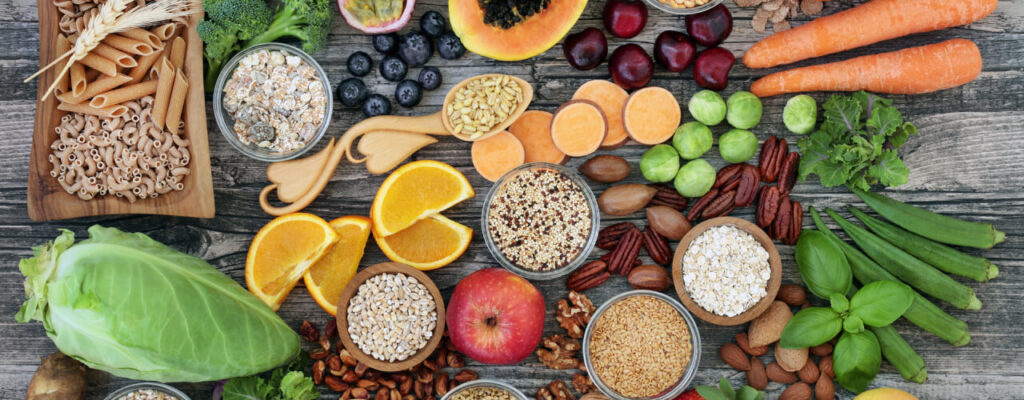Have you been living with constant chronic pain? If so, the pain might have become unbearable. Pain and inflammation are two health issues that affect much of the population in America. According to the National Institutes of Health, one in four Americans suffer from pain lasting longer than 24 hours.
Thankfully, there are ways for you to decrease the amount of discomfort you’re in. By simply switching up your eating habits for healthier alternatives, and seeing a physical therapist daily, you can dramatically reduce your pain symptoms. Read on to learn more about changing your diet, and how it can help reduce inflammation.
1. Eat more leafy greens in your diet!
Have you ever noticed how the colors of recommended fruits and vegetables create a rainbow? This “rainbow” of fruits and vegetables is excellent for heart health and boosted immunity. Eating colorful foods also fights inflammation. Leafy, green vegetables are sources of vitamin A, and adequate vitamin consumption is key to maintaining homeostasis. Also, the National Institutes of Health explains, leafy vegetables provide a protective effect against diabetes and cardiovascular health problems.
2. Make sure you’re eating fruit.
Fruits provide an excellent source of inflammation-fighting nutrients, reports the Harvard Health Publishing. Bananas, strawberries, oranges, and other fruits are a great part of a nutritious diet. Enjoy sour foods? Sour cherries, while tart, make an excellent addition to a diet that seeks to reduce pain and inflammation as well. Furthermore, they can be used in dishes for any meal, including dessert. Natural sugars also help curb cravings for sweet treats which are normally made with granulated sugar. This kind of sugar is associated with inflammation, so try to limit your intake as much as possible.
3. Kick the carbs.
Unhealthy carbohydrates include all excessively processed starches. However, items with a higher starch content, such as wheat flour and whole-grain foods, are associated with improved health.Knowing how to properly prepare your food in an anti-inflammatory diet is important as well. You should not fry foods or order fried foods for take out or when you go to a restaurant. Instead, choose foods that have been grilled, roasted, or steamed!
4. Don’t forget your omega-3s!
Omega-3s are most commonly found in seafood and nuts. The body uses these essential acids to form the building blocks of proteins and stimulate the immune system.Make sure that if you’re taking fish oil pills for omega-3 inflammation protection, you’re also adding more actual fish to your diet! The fish that have the highest Omega-3 fats are herring, salmon, trout, sardines, mackerel and tuna. All of these may provide some pain relief when inflammation is the culprit.
5. Enjoy some coffee or tea.
The caffeine within a cup of coffee or tea also possesses antioxidant properties, reducing pain and inflammation. Don’t go overboard though, as too much caffeine may have an adverse effect on the body such as increased heart rate and shakiness. Avoid drinking caffeinated beverages in excess.
6. Eat some yogurt for breakfast, or in a smoothie!
The probiotics within yogurt restore the natural flora of the digestive tract, reducing pain from eating certain foods. If you enjoy frozen yogurt, there’s good news for you! Fro-yo can be a healthy alternative to ice cream and other sweet treats.
7. Try spices known for their antioxidant properties.
Did you know that spices such as sage, cinnamon, cardamom, and garlic possess antioxidant properties? Antioxidants help your body by eliminating unbound hydrogen atoms, (also known as free radicals) within tissues. When free radicals come into contact with healthy tissue, they produce an inflammatory response. It’s kind of like magic!
8. Love chocolate? Try dark.
Many chocolate lovers enjoy milk chocolate treats above all else. However, according to MoveForwardPT, dark chocolate can reduce your risk for heart disease, mental decline, diabetes and blood pressure. These health conditions affect risk for chronic inflammation and pain, so increasing dark chocolate in the diet may lead to better management of pain overall!
9. Watch what you’re drinking.
Food is not the only culprit when it comes to pain and inflammation – even what you drink plays a huge part! Sodas contain lots of unhealthy preservatives such as sodium benzoate, not to mention high amounts of sugar. Excessive alcohol drinking should also be avoided as it can cause issues with inflammation as well.
Get additional assistance with physical therapy!
It’s obvious that no one wants to live an uncomfortable life because of pain and inflammation. These issues affect millions of people, however, taking the right approach to managing these conditions can make all the difference. What are you waiting for? Make an active change in your life today. Discover how the right combination of diet and physical therapy can reduce inflammation by contacting our office.
Sources:
- www.arthritis.org/about-arthritis/understanding-arthritis/arthritis-statistics-facts.php
- www.eatingwell.com/article/17291/foods-that-fight-pain/
- www.ncbi.nlm.nih.gov/pmc/articles/PMC4991921/
- www.moveforwardpt.com/benefits/Default.aspx
- www.health.harvard.edu/staying-healthy/foods-that-fight-inflammation
Tags: wellness, pt, health, healthytips, physicaltherapy, healthandwellness, achesandpains, naturalpainrelief, physicaltherapist
